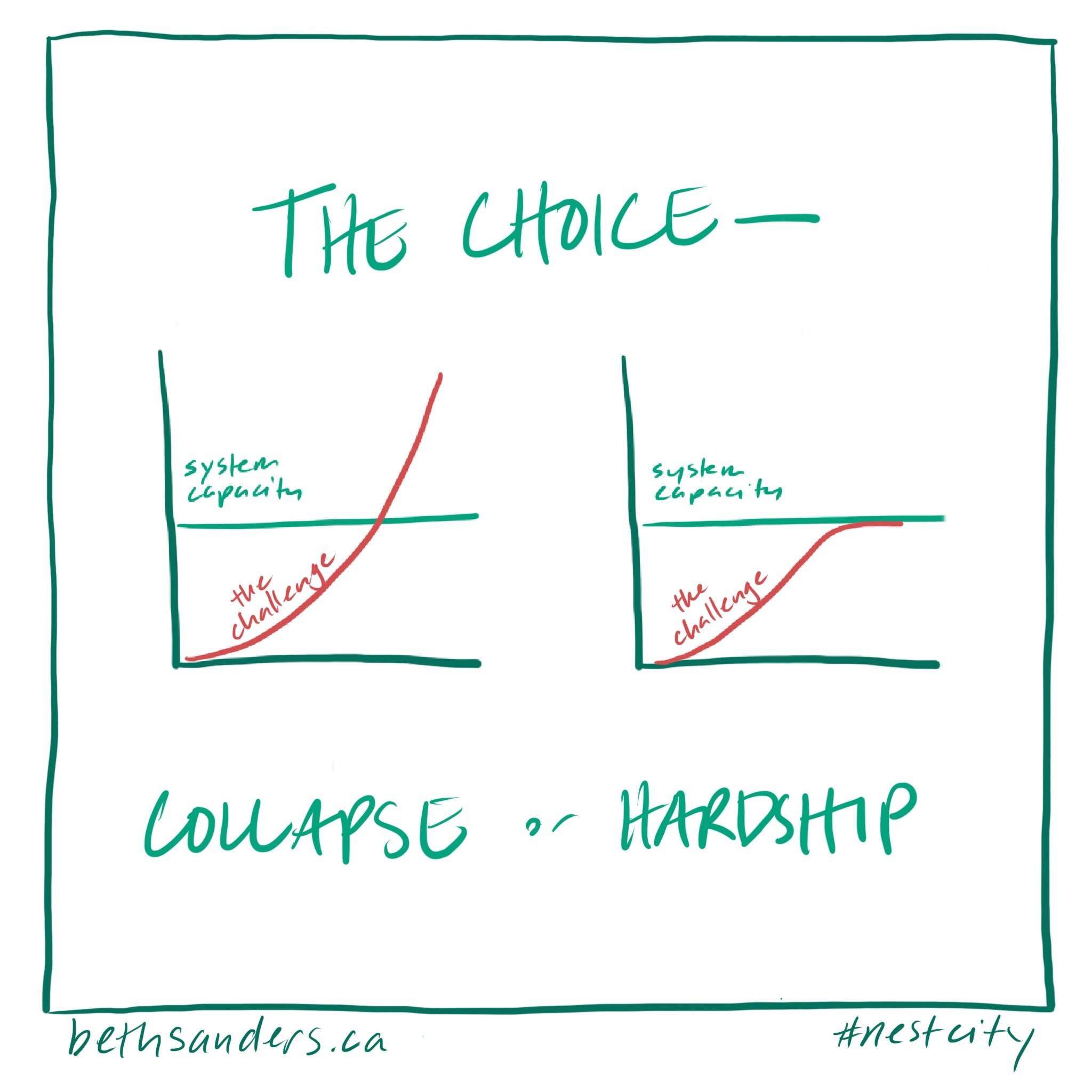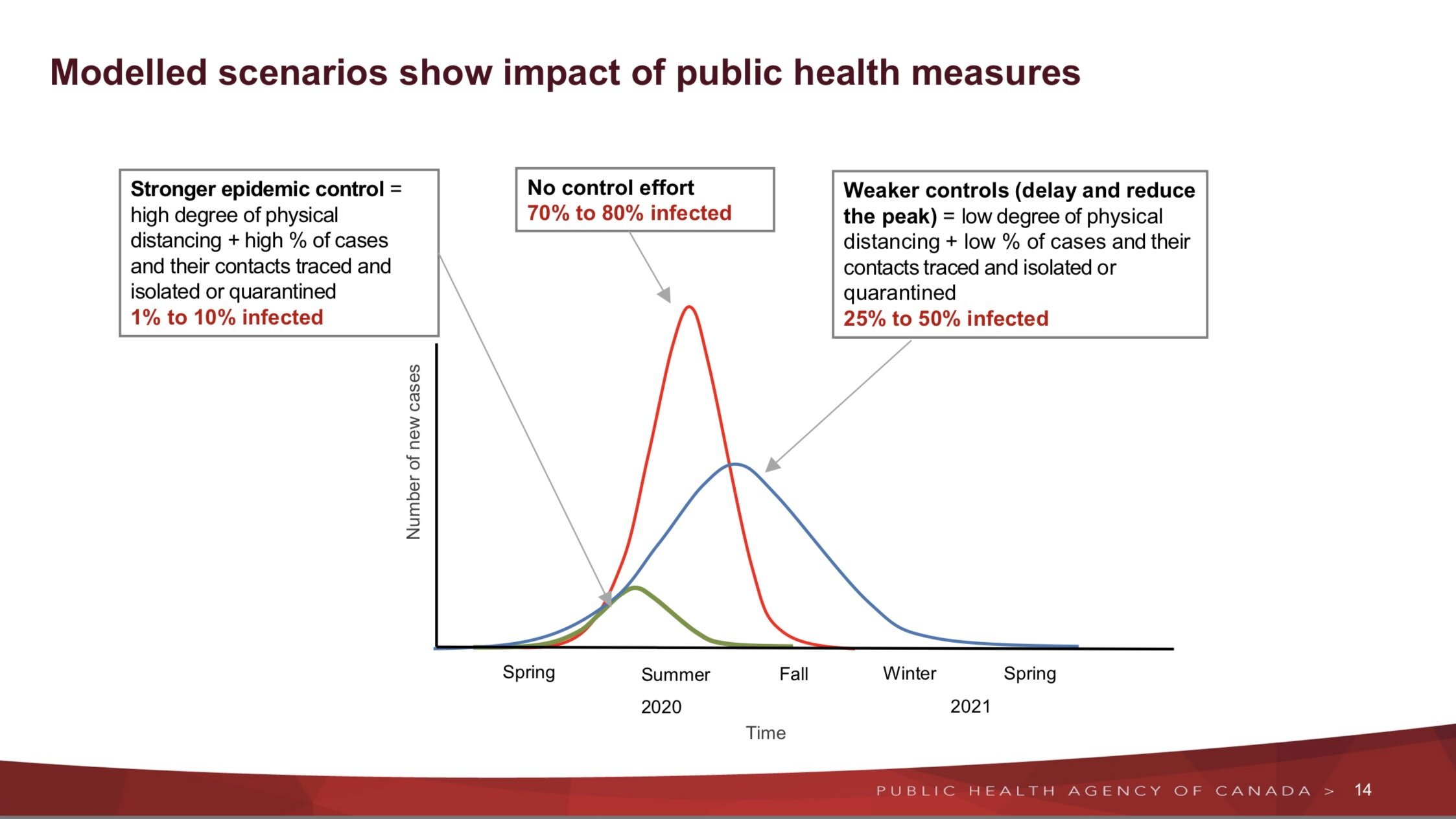Collapse or Hardship
We have two options to choose from: collapse or hardship. For valid life or death reasons, we have chosen the latter. We have chosen the hardship of physical distancing, and the hardship of tough economic conditions to avoid collapse of our healthcare systems. In the process, new ways of thinking, making and doing are enabling us to handle the situation as best we can. This ability we have to adapt is what will pull us through the health and economic challenges we are experiencing, yet there is another strategic imperative for us to acknowledge as we allocate resources to improve our economic conditions. If we ignore the other curve that needs to flatten—the rise in global temperature—we choose collapse.
Our ability to think, make and do new things can help us crawl out of the current economic crisis and flatten the other curve. We have a choice to make: flatten one curve or two. To do this, we need to:
Establish and use healthy feedback loops
Look stark truths in the eye
Acknowledge the resilience that comes with new work (new ways of thinking, making and doing)
Acknowledge the trauma and grief of endings
Make a conscious transition to energy systems that nourish life in our cities and communities
The new work we need happens on the ground in our communities and cities. Let’s flatten the temperature curve to resolve today’s economic crisis.
This is the first in a series of posts about the role of cities—and the new work we generate in our cities—to resolve our health, economic and climate crises. I start with the example of healthy feedback loops that we are experiencing right now with the coronavirus pandemic
Healthy Feedback Loops
Health and political leaders across Canada have been very clear: we have the power to shape our experience. The modelling our chief medical officers of health are using, now shared with Canadians, shows that our choices impact the number of COVID-19 cases, hospitalizations and deaths. The Public Health Agency of Canada’s message on April 9, 202 was clear: “action now determines our future.”*
Compared to the Spanish Flu of 1918, we have a new body of work to rely on in our collective choice-making: modelling. Our health officials have the capacity to better understand a disease, how it moves from human to human, and calculate the effects of its transmission on the health of our species. With this understanding, we are able, as a country and as a species, see scenarios based on the percentage of population infected by COVID-19. The same result is that if the infection rate is low, the rates of hospitalization and death are also lower.
Source: Public Health Agency of Canada
The most effective strategy to handle the pandemic is captured in two words: control and capacity. Another body of work, again new expertise since the Spanish Flu, is our assessment of the capacity of our health care systems to accommodate infection scenarios. If the capacity of the health care system is lower than what will be needed, it will collapse. This means two actions are necessary: control the rate of infection and increase the capacity of our healthy care system.
Source: Public Health Agency of Canada
Controlling the rate of infection is in the hands of Canadians. While we hear guidance and instructions from our chief medical officers of health, it our choices that dictate our future. Here’s why it matters: if we take no action to control infection, we should expect an infection rate of seventy to eighty percent and over 300,000 deaths. And with this, a collapse of our health care system.
Source: Public Heath Agency of Canada
We rely on the work of our public health officials to guide us through this life and death situation. We rely on their expertise and inventiveness to do this on our behalf. We trust that they are doing the best possible work they can under difficult circumstances. And we do what they ask: high degrees of physical distancing, isolation and quarantine. We do this because of a vital feedback loop that connects actions with consequences. It is not necessary to like the information in a feedback loop to recognize that action is necessary. When it is life or death, however, we see it more clearly.
“It is not necessary to like the information in a feedback loop to recognize that action is necessary. When it is life or death, however, we see it more clearly.”
When we choose to flatten the curve we are not choosing collapse. We are choosing to reorganize our day-to-day behaviour to minimize the consequences of an unchecked, or inadequately controlled, curve. In the simplest of terms, this choice means we need to undertake two key activities:
Create feedback loops that help us understand the consequences of our chosen actions. This will help us understand if we are getting the results we want and recalibrate if necessary. This information will inform how we allocate our resources.
Reallocate resources to ensure that helpful actions are prioritized and harmful actions are minimized or eliminated. Constant review of how we allocate our resources is necessary, based on feedback loops that tell us what gets us the results we want.
A healthy feedback loop is one where the information is integrated into our decision making. If we ignore feedback loops, or don’t allow our resource allocation to be informed by feedback, then we relinquish our conscious role in our own future. Choosing to ignore information and evidence, because it is inconvenient or hard to accept, is not responsible behaviour.
“Choosing to ignore information and evidence, because it is inconvenient or hard to accept, is not responsible behaviour.”
What feedback loops are you most appreciating right now, even if you don’t like what they tell you?
In the next post, Two Stark Truths, I will examine two “endings” that are proving hard for us to accept, and four simultaneous courses of action.
* COVID-19 in Canada: Using data and modelling to inform public health action, Public Health Agency of Canada. https://www.canada.ca/content/dam/phac-aspc/documents/services/diseases/2019-novel-coronavirus-infection/using-data-modelling-inform-eng.pdf





